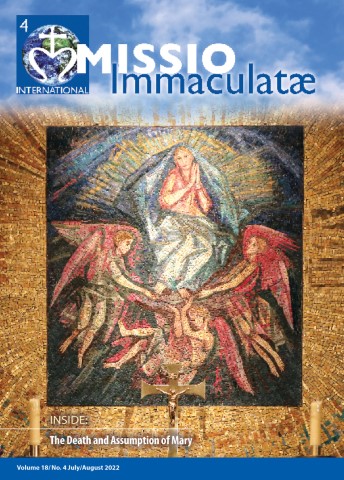Undoubtedly, the Brown Scapular of Our Lady of Mt. Carmel is one of the most popular and well-grounded Marian devotions and sacramentals in the Church. It is to be worn as a sign of one’s entrustment or consecration to Our Lady, a reminder of her presence in our lives, and of the continual need to take refuge in her Immaculate Heart for protection from evil. To really benefit from the Brown Scapular, one must not only live in chastity according to one’s state in life, and pray certain Marian prayers each day, like the Little Office of the Blessed Virgin Mary or the Holy Rosary, but also commit oneself to a serious prayer life, contemplative prayer, a deep interior life, as lived out and promoted by the Carmelite Order.
On July 16 the Church celebrates the memorial of Our Lady as patroness of the Carmelite Order. Through the Carmelite Order, Our Lady has given to the Church wonderful saints like St. Simon Stock, St. Mary Magdalen de Pazzi, St. Teresa of Avila, St. John of the Cross, St. Elizabeth of the Trinity, St. Therese of Lisieux, St. Teresa Benedicta of the Cross, and Third Order saints like the most recent Pope St. John Paul II.
During the apparition to the three children in Fatima, Portugal, on October 13, 1917, Mary appeared as Our Lady of Mt. Carmel. Subsequently, the oldest of the three children, Lucia, would herself become a Carmelite nun, taking the name of Sr. Maria Lucia of Jesus and of the Immaculate Heart. She, too, is on the path to sainthood as another gift of our Blessed Mother to the Church.
The Carmelite Order, a strictly contemplative religious order, is Our Lady’s gift to the world and to the Church. Through the Order, Our Lady extended a personal gift to all of us when she gave the Brown Scapular to St. Simon Stock, on July 16, 1251, promising that those who are enrolled in the Scapular and die wearing it will not suffer the fires of Hell. The Scapular is a sign of consecration, of belonging entirely to God and to the Mother of God, who in turn is our Mother in the order of grace.
Carmelite Father Kieran Kavanaugh wrote about the Brown Scapular: “The scapular is a Marian habit or garment. It is both a sign and pledge. A sign of belonging to Mary; a pledge of her motherly protection, not only in this life but after death. As a sign, it is a conventional sign signifying three elements strictly joined: first, belonging to a religious family … especially dear to Mary, the Carmelite Order; second, consecration to Mary, devotion to and trust in her Immaculate Heart; third, an urge to become like Mary by imitating her virtues, above all her humility, chastity, and spirit of prayer.”
The Carmelites consider Our Lady as the perfect model of the interior life of prayer and contemplation to which the Order aspires, as well as our model of virtue. The celebrated author of Carmelite spirituality, Fr. Gabriel of St. Mary Magdalen de Pazzi, wrote that devotion to Our Lady of Mt. Carmel means:
… a special call to the interior life, which is preeminently a Marian life. Our Lady wants us to resemble her not only in our outward vesture [for example wearing the Brown Scapular] but, far more, in heart and spirit. If we gaze into Mary’s soul, we shall see that grace in her has flowered into a spiritual life of incalculable wealth: a life of recollection, prayer, uninterrupted oblation to God, continual contact, and intimate union with Him. Mary’s soul is a sanctuary reserved for God alone, where no human creature has ever left its trace, where love and zeal for the glory of God and the salvation of mankind reign supreme. […] Those who want to live their devotion to Our Lady of Mt. Carmel to the full must follow Mary into the depths of her interior life. Carmel is the symbol of the contemplative life, the life wholly dedicated to the quest for God, wholly orientated towards intimacy with God; and the one who has best realized this highest of ideals is Our Lady herself, ‘Queen and Splendor of Carmel.’”
So, on a devotional level, Our Lady gives us the gift of the Brown Scapular through the Carmelite Order, but the gift of the Scapular — which we should all wear and encourage others to wear as well — is meant to help us clothe our soul with the interior dispositions and virtues of the Giver of that gift. The more we strive to imitate Our Lady, the more we will become like her in everything we think, say, and do. And that really is the key to finding happiness and joy in this life and eternal happiness in the next. Just as St. Paul says in his letter to the Galatians: “It is no longer I, but Christ who lives in me” (Gal 2:20), St. Maximilian Kolbe — Franciscan saint and martyr at the Auschwitz death camp — had as his spiritual goal to be able to say: “It is no longer I who live, but the Immaculate (Mary) who lives in me.”
May Our Lady, patroness of Carmel, clothe us more and more with her graces and virtues, so that we can become living reflections of her, whose face — as Dante wrote — most resembles the face of Christ. “Look now,” said St. Bernard to Dante, “upon the face that is most like the face of Christ, for only through [the] brightness [of Mary’s face] can you prepare your vision to see Him.”

